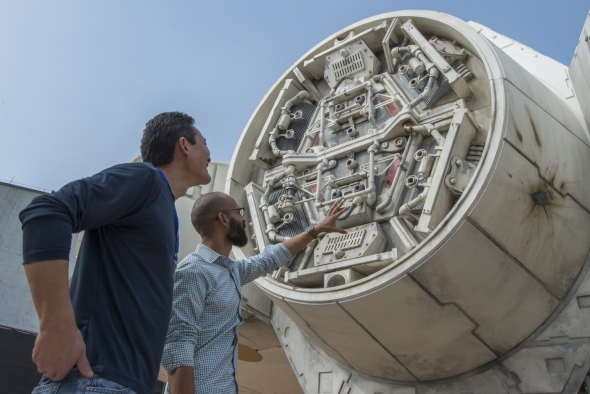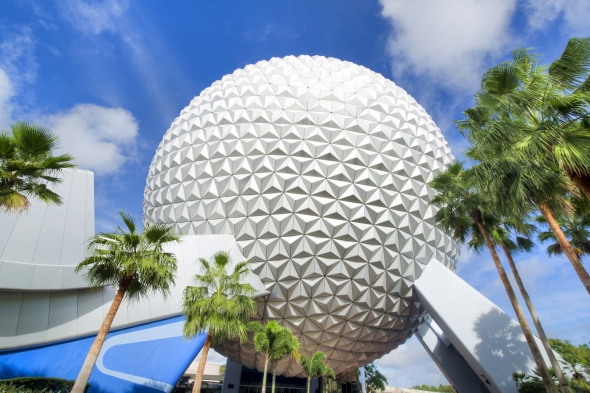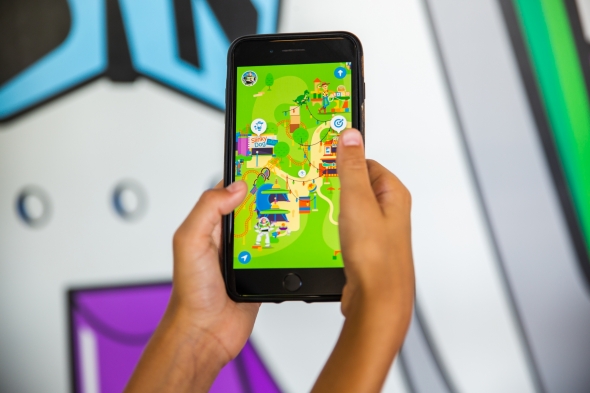3. Immersion becomes the future of theme parks
Image: Disney
Twenty years ago, the average theme park experience largely centered around spectator experiences. While Disney has long stood on the cutting edge of immersion and hands-on fun in their attractions, there were some unspoken rules about visiting theme parks. Kids could play pretend, but for adults, the experience was mostly about observation—even in thrill rides, guests were woven into the ride’s stories as passengers without much in the way of active roles in the stories. Nostalgia and spectacle were the primary ingredients most attractions aimed for.
The breaking point for immersion becoming the king buzz-word in theme parks didn’t even happen at Walt Disney World. It happened at Universal Studios with the opening of the Wizarding World of Harry Potter.
Universal Orlando Resort may have its share of foibles, but they did something spectacular with The Wizarding World of Harry Potter. They created a themed land so immersive that just walking through it was an attraction in and of itself—a magical realm that invited guests to become characters in their favorite stories. A generation raised on video games, comic books, and adoration for adventurous experiences had become the target audience for Walt Disney World vacations. The unspoken rules were being broken, and for the first time, both kids and adults were being invited, if they dared, to dive into the mists of make believe.
Disney didn’t take long to plunge into these waters. The World of Pandora at Disney’s Animal Kingdom proved a staggering success, proving immersive theme park lands were the future. Star Wars: Galaxy’s Edge has already echoed this success in Disneyland and is already taking guests into new territory never before explored by theme parks—a land where hands-on play is key, where every cast member is an actual cast member in the story, and every guest is invited to role-play as part of the adventure of a day in that galaxy far, far away. In these new lands, you don’t just ride a ride to celebrate your favorite stories—you become part of that story, even as a wanderer through the land itself.
4. The evolution of edutainment
Image: Disney
One of the biggest areas that set Disney parks apart from their competitors twenty years ago was their talent for making learning fun. Epcot, Disney’s Animal Kingdom, and even Disney’s Hollywood Studios all emphasized elements of education in their attractions, like history and culture in Epcot, the study of nature in Disney’s Animal Kingdom, and explorations of the magic of making movies at Disney’s Hollywood Studios.
Edutainment isn’t necessarily dead at Disney parks, but it has been seriously diminished over the years, especially when compared to the emphasis on IP’s and even immersion. Some great attractions with educational elements still remain, including Turtle Talk with Crush, Kilimanjaro Safaris, and Spaceship Earth, but attractions with Disney’s classic edutainment value are becoming harder and harder to find.
This is one of the changes in Disney parks that admittedly leaves us a little sad. How many children were affected in ways that changed the course of their lives by things they learned at Walt Disney World? How many young people were stirred to curiosity about space exploration, history, telecommunications, the arts, and zoology thanks to a little spark lit at The Most Magic Place on Earth? The idea seems silly, but I can say on a personal level that Disney edutainment attractions played a significant part in planting the seeds for my own career in the film industry. As The Seas With Nemo and Friends proves, education and intellectual properties don’t have to be mutually exclusive. We can only hope this particular aspect of Disney yesteryear will still make a comeback. There are so many ways it could, especially considering another major change in Disney parks the last twenty years…
5. A digital revolution
Image: Disney
It cannot be overemphasized how much the transformation of our culture by technology has changed the Disney parks experience. In 1999, the internet may have been going strong (strong enough that we all thought the world would end when our computers tried to switch over to the year 2000), but it really hadn’t affected Disney parks that much. Information for making reservations was easier to come by, and more and more people had digital cameras, but that was it.
Consider the impact of smartphones. Almost every Walt Disney World guest now carries a handheld supercomputer that can store thousands of pictures and videos on a whim, transmit their vacation via social media to almost anywhere in the world (even in a livestream), that can make and manage reservations for dining and Fastpass+, and even provide interactive entertainment in line thanks to the Play Disney app.
Even without a smartphone, try imagining a Walt Disney World vacation without a MagicBand. It still happens, but the convenience of MagicBands is undeniable—a simple bracelet that can be used as a room key, portable payment device, a Fastpass storage unit, and a magic wand to unleash personalized pixie dust at any given moment. Think about how Photopass has changed how we handle theme park photos. Disney now has the ability to transmit ride photos directly to guest’s personal devices without them even (technically) needing to scan their band. That is wizardry at work.
This digital revolution is nowhere more apparent than in Star Wars: Galaxy’s Edge. In Galaxy’s Edge, guests can turn their smartphones into an in-world Star Wars Datapad capable of hacking terminals, tuning into communication frequencies, scanning crates to learn their contents, and automatically translating Aurebesh. The information tied to guest MagicBands will track their experiences within the park and even affect character interactions. Let’s also not forget how video game culture has transformed the parks, bringing elements of virtual reality into attractions like Avatar: Flight of Passage and gamifying into rides like Millennium Falcon: Smuggler’s Run.




Add new comment